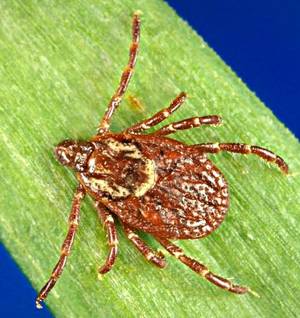Canine Rocky Mountain Spotted Fever

With some 900 humans and an even greater number of dogs infected in the US every year, Rocky Mountain Spotted Fever (RMSF) is the most-frequently reported rickettsial disease in the country.
It is caused by Rickettsia rickettsii, a species of bacteria spread by hard ticks. The major disease carriers are Dermacentor tick species such as the American Dog Tick (D. variabilis) and the Rocky Mountain Wood Tick (D. andersoni). The Brown Dog Tick (Rhipicephalus sanguineus) and the Lone Star Tick (Amblyomma americanum) have also been identified as possible RMSF carriers.
RMSF was first recognized in humans in Idaho's Snake River Valley in 1896, and was originally called black measles due to its characteristic rash. The disease was not recognized in dogs until the 1970s.
Cases have been reported from all states except Hawaii, Alaska and Maine. Despite the name, the disease is actually more common in the south-eastern states, with the disease being most prevalent in North Carolina and Oklahoma. The Rocky Mountain region actually accounts for less than one per cent of reported cases.
A strain of the infection is maintained in the wild, by hosts such as squirrels and chipmunks and successive generations of ticks. These reservoir hosts show no symptoms of disease and can remain perfectly healthy, despite a high rickettsia count in their blood. For the parasite, this is an excellent means of survival as it ensures it can be passed from rodent to tick without the rodent dying from the disease.
|
"There is no vaccine available to protect dogs or humans against [RMSF]. The use of tick-prevention products
such as Frontline, collars or dips containing amitraz, or permethrin-based products is ... recommended."
|
A tick begins life as an egg, which hatches to produce a six-legged larvae. This evolves into an eight-legged nymph and finally an eight-legged adult. The larvae and nymphs tend to prefer small mammals such as squirrels and chipmunks, while the adults prefer larger hosts, including dogs and humans.
Tick species which transmit RMSF are three-host ticks as they infest and feed on three different hosts during their life cycle. A tick infected as a larvae will carry the infection through molts and can transmit this infection to an adult host.
The ability to pass the rickettsia between different life stages is called "transtadial transmission". It can also be passed trans-ovarially by an infected female tick to her offspring. Despite this constant cycle of infection maintained between ticks and rodents, only about one to three per cent of the tick population actually carries R. rickettsii, even in endemic areas. More than 90 per cent of patients with RMSF (both canine and human) are infected between April and September, the peak time for adult and nymphal tick activity.
|
Symptoms of RMSF
|
| The symptoms of RMSF may include:
Other symptoms in dogs include some nervous signs, including a head tilt, unsteady gait, circling and changes in behavior which develop later in the disease. These symptoms are uncommon in humans. There may also be respiratory problems, problems with nosebleeds, painful, bloodshot eyes, an irregular heartbeat, as well as abnormal urination if the kidneys are affected. |
RMSF is transmitted to hosts via tick saliva. However, the tick must be attached for at least five hours to transmit the infection, so daily checks and prompt tick removal are very important in preventing the disease.
The symptoms of canine infection largely mirror those of humans. While dogs are regarded as good indicators for the prevalence of human disease in an area, cats do not develop clinical signs of disease. RMSF's incubation period is between two to 14 days. The symptoms vary widely and are a result of the bacteria's ability to gather on blood vessel walls and damage them, causing blood leakage in many different places of the body. This damage can then cause small blood clots to try to block the holes in the vessel walls.
RMSF can be a very severe illness and dogs often require hospitalization. The more severe effects of the disease involve the respiratory system, central nervous system, gastrointestinal system and kidneys. Death may occur as a result of failure of any of these organ systems, or due to shock. Without prompt and appropriate treatment, RMSF can be fatal.
Purebred dogs, particularly German Shepherds, and dogs less than three years old seem more susceptible to RMSF. Dogs which recover from the illness develop a strong immunity. Dogs usually do not develop sufficient blood levels of the rickettsia to to allow them to act as reservoirs of infection, and RMSF cannot be transmitted directly from dogs to humans. However, dogs are quite capable of transporting ticks to human living areas.

The disease can be diagnosed with several special blood tests a few weeks apart, to check for increasing levels of antibodies to rickettsia in the blood. However, as a definitive diagnosis can take some time, treatment is normally started before the results of the tests are confirmed. RMSF treatment involves supportive care and antibiotics, normally tetracyclines, although chloramphenicol and fluoroquinolones are also used in animals.
|
Anti-tick treatments
|
Pet Shed's most popular solutions for ridding your pet of ticks
|
There is no vaccine available to protect dogs or humans against this disease, so avoiding ticks is the best form of protection. The use of tick-prevention products such as Frontline, collars or dips containing amitraz, or permethrin-based products is also recommended throughout the tick season, in conjunction with daily inspections. Your veterinarian can recommend an appropriate product for your pet.
If you, or your pet are found to have a tick, it should be removed immediately. Do not touch the tick with your fingers and ensure it is pulled out gently backwards, grasping the tick as closely as possible to the mouth parts to avoid leaving the head embedded in the skin. It is a good idea to keep the tick in a sealed jar to assist the doctor or veterinary to make a diagnosis in the event a tick-related disease such as RMSF is suspected.
If you do suspect a tick-related disease, visit your doctor or take your pet to the veterinarian as soon as possible.
|
References
|
| Tilley L.P., Smith F.W.K. The Five Minute Veterinary Consult Canine and Feline.
Second Edition. Lippincott Williams & Wilkins, Baltimore, 2000. Rocky Mountain Spotted Fever. Centers for Disease Control and Prevention. http://www.cdc.gov/ncidod/dvrd/rmsf/index.htm Rocky Mountain Spotted Fever. Pet's Health. Colombia Animal Hospital. http://www.cah.com/dr_library/rsms.html Rocky Mountain Spotted Fever. Directors of Health Promotion and Education. http://www.dhpe.org/infect/rms.html Greene C.E. JAVMA Zoonosis update: Rocky Mountain Spotted Fever. American Veterinary Medical Association, 1987. http://www.avma.org/reference/zoonosis/znrmsfvr.asp Otis W.L. et al. Rocky Mountain Spotted Fever in Dogs. Department of Pathology Clerkship, College of Veterinary Medicine, University of Georgia, 2004. http://www.vet.uga.edu/VPP/clerk/otis/ |
Frontline� is a registered trademark of Merial.